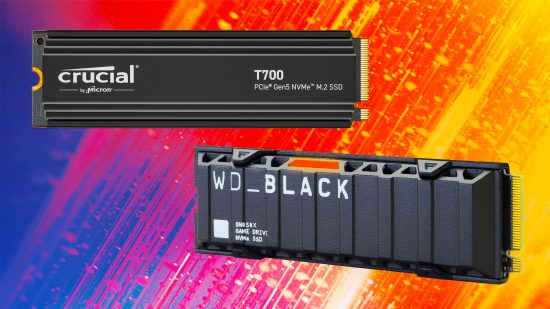Do you want faster load times? Do you need more space for the latest games? If so, our guide to the best SSD for gaming is the place to be. Here you’ll find our pick of the best gaming SSDs for various prices, from the fastest SSD to the best cheap SSD, ensuring there’s some solid state goodness for everyone.
You won’t see any SATA SSDs in our list because we don’t recommend them for normal PC builds anymore. These days, the cost difference between M.2 SSDs and SATA SSDs is marginal, and the only remaining advantage of 2.5-inch SATA SSDs is that they can stretch to 8TB sizes whereas M.2 drives are limited to 4TB. Hard drives are still worth getting for cheap large storage where speed isn’t a concern.
We recommend at least 1TB capacity for your main drive, as even a basic Windows installation can take up nearly 20GB and many modern games use well over 100GB. You can get 1TB M.2 NVMe SSDs for under $100 now. Once you’ve chosen your SSD, make sure you also read our full guide on how to install an M.2 SSD.
Everything you’ll find on this list has been extensively tested by our in-house experts at Custom PC. You can find out more information on how we test SSDs below, but be reassured that every product we recommend will make a huge difference in your rig.
Why you can trust us ✔ Custom PC has over 20 years of experience testing hardware. We share honest, expert advice to help you buy the best. Find out how we test.
The best SSDs for gaming in 2024:
- Crucial T700 – the fastest SSD for gaming
- Solidigm P44 Pro – the fastest PCIe 4 SSD for gaming
- WD Black SN850X – the best PCIe 4 SSD
- Sabrent Rocket NVME 4.0 – the best value PCIe 4 SSD
- Samsung 980 – the best PCIe 3 SSD for gaming
- WD Blue SN550 – the best cheap M.2 SSD
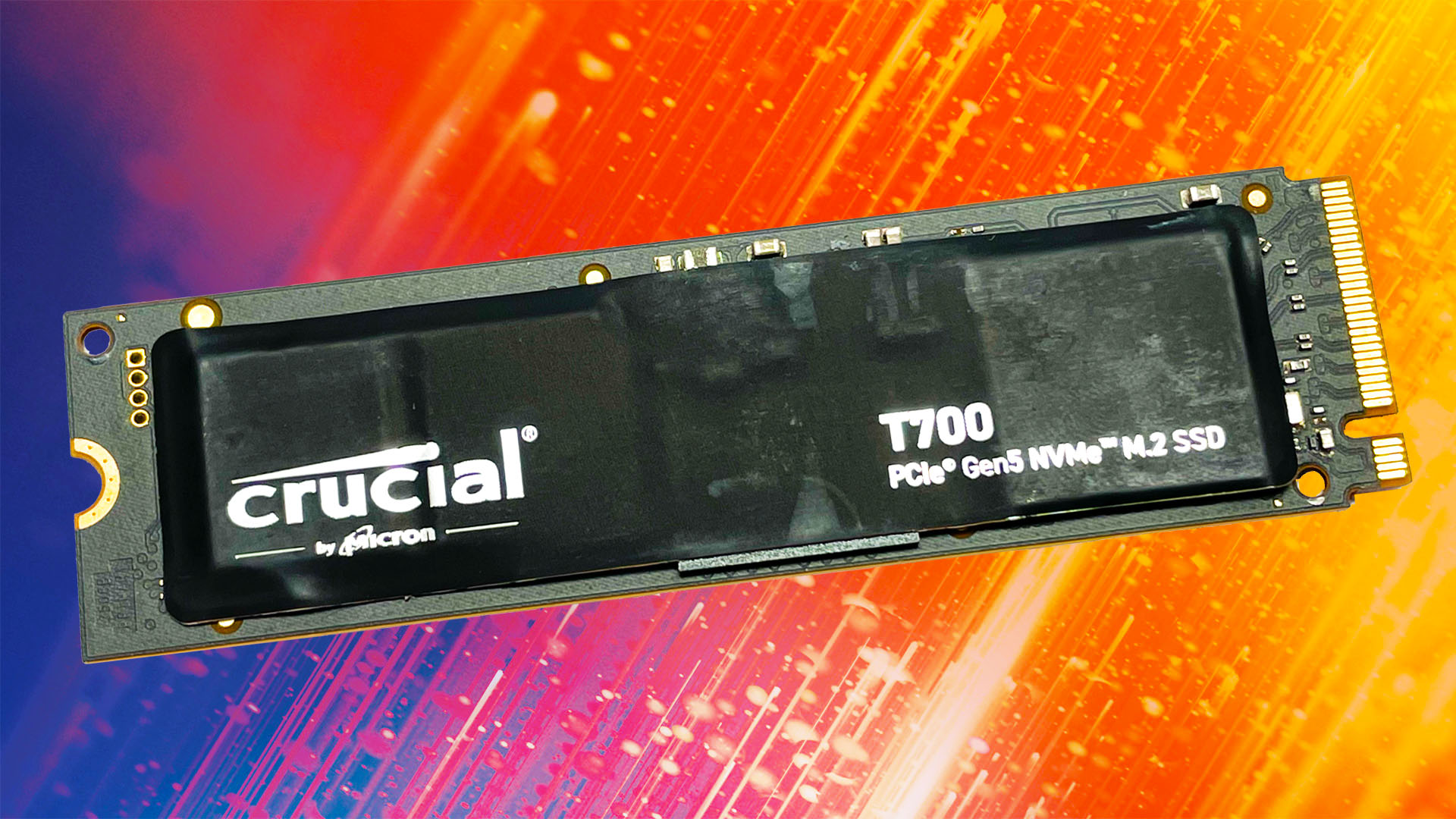 1. Crucial T700
1. Crucial T700
The fastest SSD for gaming is the Crucial T700.
Crucial T700 specs:
| Interface | PCIe 5 |
| Cache | 1 GB LPDDR4 DRAM per terabyte |
| Heatsink option | Yes |
| Capacities available | 1 TB, 2 TB, 4 TB |
| NAND | TLC |
| Controller | Phison E26 |
| Endurance rating | 600TBW (1 TB model), 1,200TBW (2 TB model) and 2,400TBW (4 TB model) |
| Warranty | Five years |
Pros
- Incredible sequential speeds
- Available in 4 TB capacity
- Excellent 4K Q32T16 speeds
Cons
- Very expensive per GB
- Requires expensive motherboard
- Throttles without large heatsink
PC SSDs don’t come any faster than the Crucial T700. If you’ve got a need for speed, and want to take full advantage of your new motherboard’s PCIe 5 M.2 slot, this is the drive for you.
In our tests, the T700 hit a blistering sequential read speed of 12,378 MB/s, which is double the speed you get from many PCIe 4 drives. Be warned, though, it gets hot. We recommend either buying the version with the heatsink or using a large motherboard heatsink.
The Crucial T700 isn’t cheap, and you can get a better price per GB elsewhere. But you want the fastest SSD available, and this is it.
Read our full Crucial T700 review.
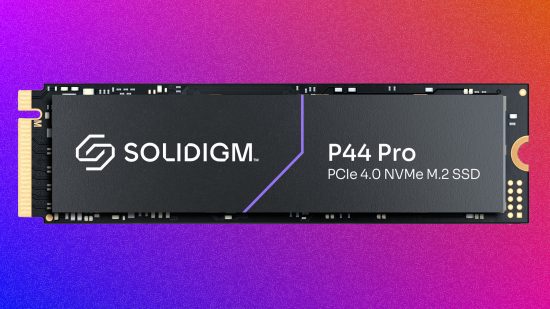
2. Solidigm P44 Pro
The fastest PCIe 4 SSD for gaming is the Solidigm P44 Pro.
Solidigm P44 Pro specs:
| Interface | PCIe 4 |
| Max capacity | 2TB |
| Formatted capacity | 1.81TB |
| Controller | SK Hynix Aries |
| Endurance rating | 750TBW (1TB), 1,200TBW (2TB) |
| Warranty | Five years |
| NAND | TLC |
Pros
- Superfast load times
- Excellent sequential speeds
- Competitive price
Cons
- Not as cheap as similar PCIe 4 M.2 SSDs
- Other SSDs have higher endurance ratings
- Heatsink required to prevent throttling
The simple fact is that the Solidigm P44 Pro is the fastest PCIe 4 SSD we’ve tested when it comes to game load times. Other drives offer faster peak performance in some benchmarks but for most home users it’s game load speed that is the most demanding test of an SSD.
Here, the Solidigm shines. It’s also priced keenly so you’re not paying a premium for that gaming speed. However, there are cheaper PCIe 4 M.2 SSDs if you want a lower cost per GB.
Read our Solidigm P44 Pro review.
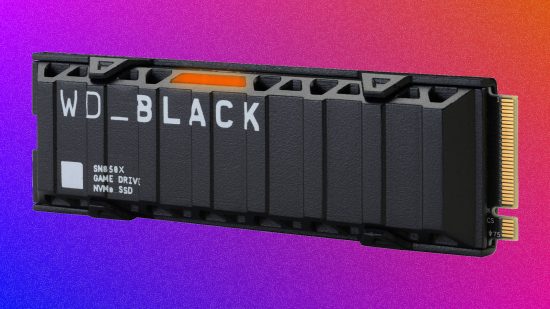
3. WD Black SN850X
The best PCIe 4.0 SSD is the WD Black SN850X.
WD Black SN850X specs:
| Interface | PCIe 4 |
| Max capacity | 4TB |
| Controller | WD 20-82-20035-B1 |
| Endurance rating | 750TBW (1TB), 1,200TBW (2TB) |
| Warranty | Five years |
| NAND | TLC |
Pros
- Excellent speeds
- Competitively priced
- 4TB model available
Cons
- Sequential speeds aren’t chart-topping
- Cheaper SSDs won’t feel much slower
- Toasty peak temperatures with stock heatsink
Although it’s not the absolute fastest PCIe 4.0 drive we’ve tested, the WD Black SN850X game load times are fantastic and its price is equally keen. It’s often on sale, meaning you can snag a real bargain with this SSD if you’re patient.
Its snazzy heatsink works well but costs extra, so we’d recommend going with the non-heatsink version and using your motherboard’s M.2 heatsink if it has one.
Read the full WD Black SN850X review.
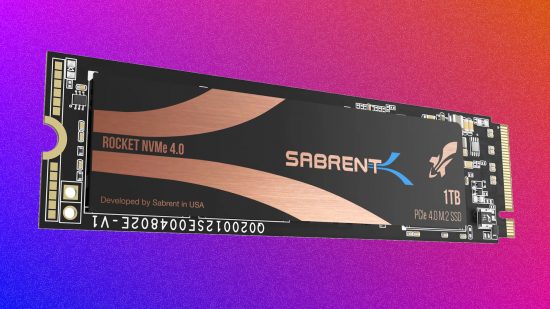
4. Sabrent Rocket NVME 4.0
The best value PCIe 4 SSD is the Sabrent Rocket NVME 4.0.
Sabrent Rocket NVMe 4.0 specs:
| Interface | PCIe 4 |
| Max capacity | 1TB |
| Formatted capacity | 931GB |
| Controller | Phison E16 |
| Endurance rating | 1,800TBW (2TB) |
| Warranty | Five years |
| NAND | TLC |
Pros
- Reasonable price
- Fast sequential transfers
- Good software
Cons
- No heatsink
- Can get toasty without extra cooling
- Competition looks better
The Solildigm P44 Pro might have the Sabrent Rocket NVME 4.0 beaten for game load speed, but otherwise the Sabrent is the faster drive. This makes the Rocket NVME 4.0 the best drive for consistent all-round SSD performance.
The Sabrent Rocket NVME 4.0 price is also very reasonable. You can even get a free copy of the excellent Acronis True Image for easily formatting and moving around your data.
Find out more in our full Sabrent Rocket NVME 4.0 review.
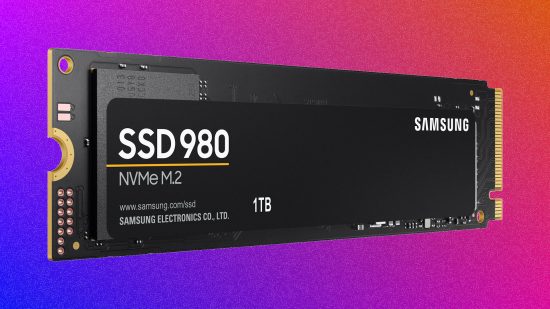
5. Samsung 980
The best PCIe 3.0 SSD for gaming is the Samsung 980.
Samsung 980 specs:
| Interface | PCIe 3 |
| Max capacity | 1TB |
| Formatted capacity | 931GB |
| Controller | Samsung Pablo |
| Endurance rating | 600TBW (1TB) |
| Warranty | Five years |
| NAND | TLC |
Pros
- No need for a heatsink in most cases
- Good warranty and endurance
- As fast as pricier SSDs in some tests
Cons
- Similarly-priced PCIe 4 SSDs are faster
- Average 4K random read and write performance
- No 2TB option
Although an older drive – and one that didn’t fare that well in our original review thanks to its high price – the Samsung 980 is now a great value PCIe 3 SSD that still has ample performance for most users’ needs.
Recent price drops make it an excellent value option and many of us won’t need to step up from a PCIe 3 drive to a hotter-running PCIe 4 drive. So, it’s a good way to save some money on your system build. If you need a drive that’s designed for hardcore gaming, and don’t mind spending more, check out the Samsung 980 Pro.
Read more in our full Samsung 980 review.
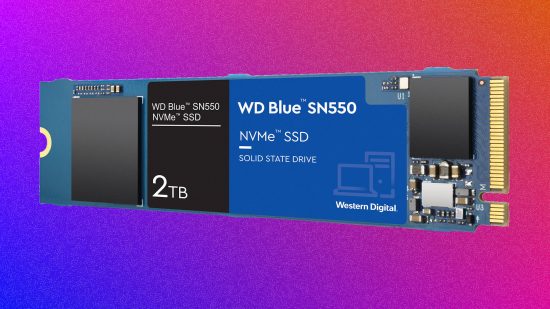
6. WD Blue SN550
The best cheap SSD is the WD Blue SN550.
WD Blue SN550 specs:
| Interface | PCIe 3 |
| Capacities | 250GB, 500GB, 1TB |
| Max sequential read/write speed | Up to 2,400MB/s / 1,950MB/s (1TB) |
| Max random read/write speed | Up to 410K/405K IOPs (1TB) |
| Controller | WD in-house |
| Endurance rating | Up to 600TBW (1TB) |
| Warranty | Five years |
| NAND | TLC |
Pros
- $55 for 1TB
- Good read speed for the cash
- No heatsink required
Cons
- Much faster SSDs cost just $30 more
- No DRAM cache
- Tiny SLC cache
A basic, budget SSD, the WD Blue SN550 can’t claim record-breaking read and write speeds or stellar write endurance writings. However, what it does offer is adequate performance to make your system feel snappy in use and keep game-load times low without breaking the bank. It’s among the cheapest M.2 SSDs around and still has enough performance for most systems.
Read our WD Blue SN550 review.
SSD FAQ
What is an SSD?
An SSD or solid-state drive, is a type of long-term storage for computers. That makes it different from RAM or memory, which doesn’t store data once a computer is turned off. The other main type of long-term computer storage is the hard drive.
SSDs and hard drives differ by how they store data. SSDs use silicon chips like those used to create CPUs and GPUs whereas hard disk drives (HDDs) use spinning platters of a magnetic material over which a read/write head moves, to read/write a spiral of data on the disk’s surface.
SSDs are much more resistant to physical shocks than HDDs and they can access data far faster too. Hard drives generally max out at 500MB/s (megabytes per second) read and write speeds with access times (how quickly an individual piece of data can be found) of 5-10ms. Modern SSDs can read/write at 7,000MB/s and have access times of 50-100µs – 100x faster than a hard drive. However, hard drives are much cheaper per unit of storage, with 4TB hard drives costing $70 and 4TB SSDs costing around $200.
We strongly recommend using an SSD as your main system drive so that Windows boot and game load times are as fast as possible. Hard drives are good for storing lots of less frequently-accessed data, such as old photos and videos.
Do SSDs need a heatsink?
Older SSDs never needed a heatsink, but the latest PCIe 4 and PCIe 5 M.2 SSDs can run so fast and hot that they benefit from a heatsink. Without a heatsink they might slow down to avoid overheating. Many modern M.2 SSDs come with an integrated heatsink or your motherboard will likely have one or more heatsinks that are well worth using.
Do SSDs need defragging?
No. SSDs should never be defragged as doing so actively shortens their life. Leave Windows or your chosen operating system to manage the drives without intervention.
Do SSDs slow down when full?
Yes. SSDs won’t generally get any slower to read from when full but writing performance can drop as the drives run out of space for fast write caches. You’re unlikely to notice the difference before realizing you simply need more space for your data anyway, though.
Are SSDs better than hard drives?
In almost every possible way, SSDs are better than hard drives. They’re smaller, lighter, much more physically durable, and much faster. The only advantage of hard drives is their price for the amount of storage they provide with current SSD prices being around $0.1 per GB for SSDs and around $0.015 per GB for hard drives.
How we test SSDs
We’ve been testing SSDs ever since they first arrived on the scene so know how to push them to their limits and find out what matters when it comes to SSD performance. We run a battery of tests using CrystalDiskMark and AS-SSD, as well as real world tests, and carry out thermal tests to check for throttling.
We test a variety of read-and-write scenarios, including sequential and random tests, and we also measure the IOPS in AS-SSD. Stability and write endurance isn’t a meaningful concern for modern SSDs so we concentrate on performance in our tests.
Found the right SSD for your gaming PC? Why not check out our best graphics card and best CPU for gaming guides to complete your setup?
